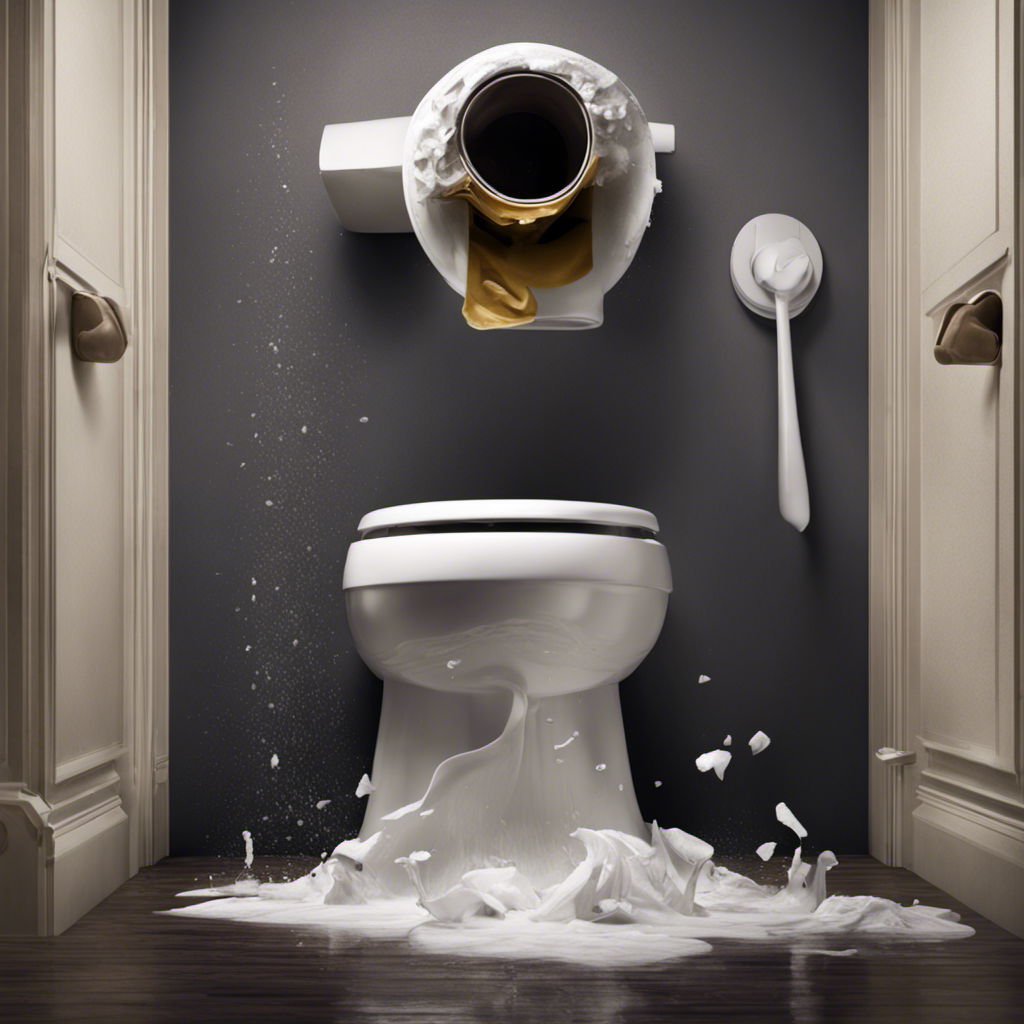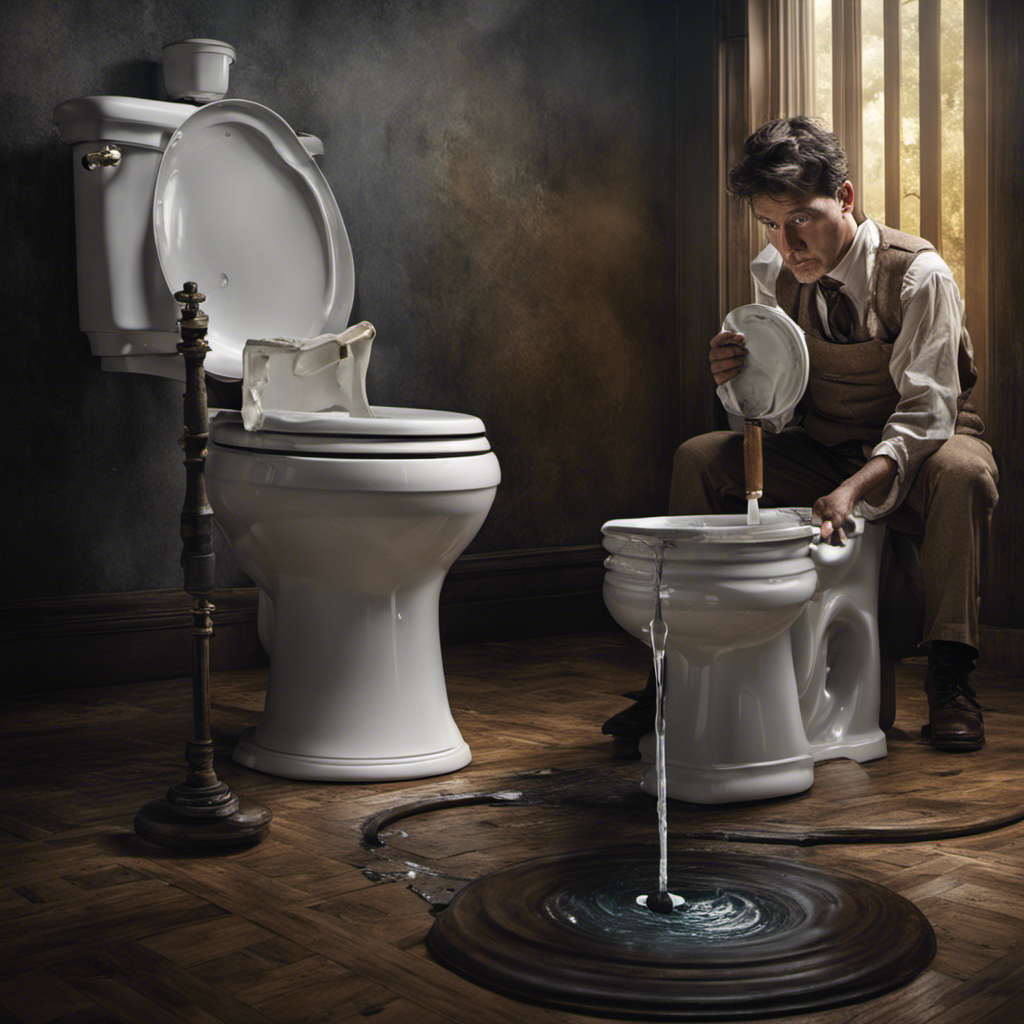I’ll tell you, folks, dealing with a clogged toilet is no fun. Did you know that a whopping 90% of toilet drainage issues are caused by simple blockages? That’s right, most of the time, it’s something that can be easily fixed.
In this article, we’ll dive into the various reasons why your toilet may be refusing to drain properly. From clogged traps to faulty flapper valves, we’ll cover it all.
So, let’s get down to business and unclog that toilet!
Key Takeaways
- Blockages in the toilet can be caused by foreign objects or excessive waste, and can be resolved using a toilet plunger or drain snake.
- A clogged toilet trap can restrict water flow and can be cleared using a plunger or toilet auger.
- A faulty flapper valve can cause water leakage and inefficient flushing, and should be replaced to prevent water wastage.
- Issues with the main sewer line, such as tree root intrusion or collapse, require professional inspection and repair to resolve.
Possible Blockages
One possible reason why your toilet won’t drain could be due to blockages in the pipes. Blockages can occur when foreign objects such as toilet paper, sanitary products, or even excessive waste build up and clog the pipes.
When faced with a blocked toilet, there are a few steps you can take to try and resolve the issue. Firstly, you can try using a toilet plunger. Place the plunger over the drain hole and vigorously pump it up and down to create suction and dislodge the blockage.
If the plunger doesn’t work, another option is to use a drain snake. Insert the snake into the toilet drain and rotate it to break up and remove the blockage. Remember to be gentle to avoid causing any damage to the pipes.
Clogged Toilet Trap
The clogged trap in the toilet is likely causing the drainage problem. When the trap becomes blocked, it restricts the flow of water and prevents waste from being flushed away properly.
To address this issue, there are a few things you can try before seeking professional plumbing assistance:
-
Toilet plunging: Use a plunger to create suction and dislodge the blockage. Ensure a tight seal around the drain and use firm, consistent plunging motions.
-
Pro tip: Add some petroleum jelly to the plunger’s rim for a better seal.
-
Using a toilet auger: This tool can be inserted into the toilet drain and twisted to break up the clog. It is especially effective for removing stubborn blockages.
-
Chemical drain cleaners: These products can dissolve certain types of blockages, but use them with caution and follow the instructions carefully.
If these methods don’t work, it’s best to contact a professional plumber who can assess the situation and provide the necessary assistance.
Faulty Flapper Valve
If you’re experiencing a faulty flapper valve, it’s important to replace it as soon as possible to prevent water wastage. The flapper valve is a crucial component in the toilet tank that controls the flow of water into the bowl. When it malfunctions, it can cause continuous water leakage or inefficient flushing, leading to higher water bills and potential damage to the surrounding area.
To replace the flapper valve, follow these steps:
- Shut off the water supply to the toilet.
- Drain the tank by flushing and removing any remaining water.
- Remove the old flapper valve by disconnecting it from the flush valve.
- Install the new flapper valve by attaching it to the flush valve and ensuring a secure fit.
Regular toilet tank maintenance, including flapper valve replacement, is essential for optimal toilet performance and water conservation. By addressing any issues promptly, you can avoid more significant problems down the line, such as issues with the main sewer line.
Issues With the Main Sewer Line
Dealing with issues in the main sewer line can be a messy and expensive problem. When it comes to the main sewer line, there are two common culprits that can cause major issues: tree root intrusion and sewer line collapse.
-
Tree root intrusion:
-
Tree roots are naturally drawn to sources of moisture, including sewer lines.
-
As tree roots grow, they can infiltrate and damage sewer pipes, leading to blockages and backups.
-
Chemical root killers or mechanical root removal may be necessary to address this issue.
-
Sewer line collapse:
-
Over time, sewer lines can deteriorate and collapse due to age, shifting soil, or heavy loads.
-
A collapsed sewer line can cause complete blockage and sewage backup.
-
Professional inspection and repair are crucial to resolve this problem.
It is important to address these issues promptly to avoid further damage and costly repairs. Regular maintenance and professional help can help prevent these problems in the first place.
Inadequate Ventilation System
You can prevent issues with your ventilation system by ensuring proper airflow throughout your home. Common causes of inadequate ventilation include blocked vents, dirty air filters, and faulty fans.
If you notice that certain areas of your home feel stuffy or have a lingering odor, it could be a sign of poor ventilation. Troubleshooting tips to improve airflow include checking and cleaning vents regularly, replacing dirty air filters, and ensuring that fans are functioning properly.
Additionally, keeping doors and windows open when weather permits can help promote better air circulation. If these steps don’t resolve the issue, it may be necessary to consult with a professional HVAC technician to assess and address any underlying problems with your ventilation system.
Frequently Asked Questions
How Do I Know if My Toilet Is Experiencing a Possible Blockage?
To determine if my toilet has a possible blockage, I should look for signs like slow draining or gurgling sounds. Common causes of toilet blockages include excessive toilet paper usage, foreign objects, or a clogged sewer line. Regular toilet drain maintenance can help prevent these issues.
What Are Some Signs of a Clogged Toilet Trap?
To prevent toilet clogs and maintain the toilet trap, it is important to recognize signs of a clogged toilet trap. Look for slow drainage, gurgling sounds, and water backing up in the bowl.
How Can I Determine if the Flapper Valve Is Faulty?
To determine if the flapper valve is faulty, I would first inspect it for any visible signs of damage or wear. If necessary, I would replace the flapper valve to troubleshoot any issues with toilet drainage.
Are There Any Warning Signs Indicating Issues With the Main Sewer Line?
Warning signs of issues with the main sewer line include multiple drains clogging simultaneously, gurgling sounds from drains, and foul odors. Troubleshooting steps may involve using a sewer camera inspection or consulting a professional plumber for further assistance.
How Can I Tell if My Toilet Has an Inadequate Ventilation System?
If my toilet has an inadequate ventilation system, it can lead to toilet drainage problems. Common causes include clogged vents or a blocked sewer line. It’s important to address these issues promptly to ensure proper functioning.
Conclusion
Well, isn’t this just the cherry on top of my day. After going through all the possible reasons why my toilet won’t drain, it looks like I’ve hit a dead end.
Who would have thought that a seemingly simple task of flushing could turn into a never-ending battle? I guess I’ll just have to keep my fingers crossed and hope for the best.
Maybe someday, my toilet will decide to cooperate and give me a break. But until then, I’ll just have to keep plunging away and embracing the irony of it all.










